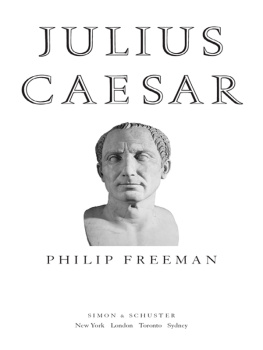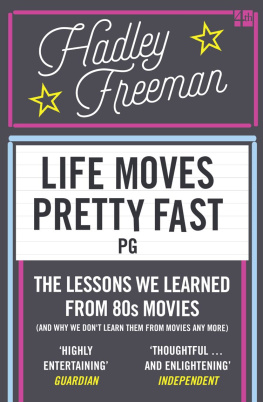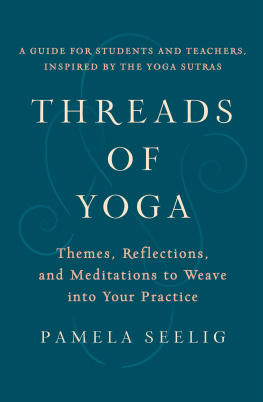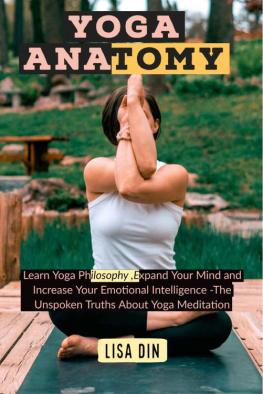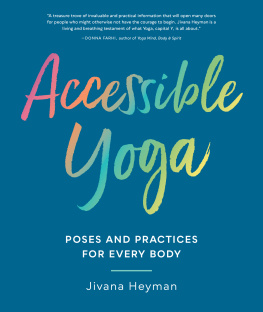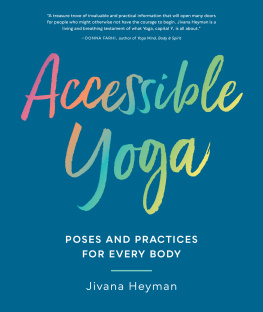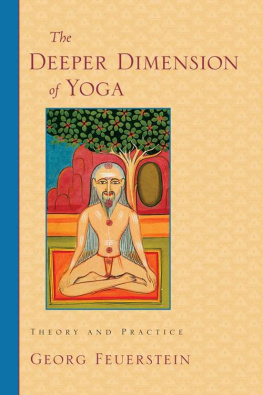Because of Richard Freemans sterling reputation, I often confront tough situations with this question: What would Richard Freeman do? His new book affirms that my faith is well-placed. Freemans tone and insight open us. Quietly, he finds whole worlds within yogas simple acts.
Eric Shaw, Yoga Journal
Collectively, these essays form an insightful and oftentimes humorous introduction to the deeper aspects of yoga philosophy, suitable for both the neophyte and the seasoned practitioner. In addition to being quite original, imaginative, and at times almost whimsical, The Mirror of Yoga is also firmly grounded in references to, and excerpts from, those yogic texts most respected by all schools of practice.
Namarupa Magazine Online
A delightful read on the aspects of yoga philosophy will provide the beginner and the advanced yogi with a much deeper insight in the wonderful world of yoga.
Organic Spa magazine
This thoughtful and beautifully written book... will take the average yogi to the next level.
New Age Retailer
ABOUT THE BOOK
The world of yoga is astonishingly rich in its array of schools and practices. Yet, as diverse as they seem, they share a common aim: the discovery of the essence of existence that can be found at the core of our being, and the liberation that comes from that discovery. With this worthy goal in mind, Richard Freeman presents an enlightening overview of the many teachings, practices, and scriptures that serve as the basis for all the schools of yogahatha, bhakti, jnana, karma, tantra, and others. He shows how the myriad forms are ultimately related, and can even be perceived to make up a vast, interpenetrating matrix, symbolizing the unity, profundity, and beauty of the ancient tradition.
Richards wide-ranging discussion includes the Upanisads and Samkhya philosophies, the Yoga Sutra of Patanjali, the eight limbs of astanga yoga, the process and purpose of hatha yoga, and much more. He also explores the role of the guru, chanting, meditation, and the yogic imperative of offering service to others. All of this is applied to the actual practice, giving the reader the tools to digest and apply the wealth of information to daily life. The Mirror of Yoga will be a welcome resource to all yogis who wish to better practice the profound philosophy underlying their practice.
RICHARD FREEMAN has been a student of yoga since 1968. His background includes studying Ashtanga, Iyengar, bhakti, and traditional hatha yoga; Western and Eastern philosophy; and Sanskrit; all of which he incorporates into the Ashtanga yoga practice as taught by his principal teacher, K. Pattabhi Jois of Mysore, India. Richard teaches at his studio, the Yoga Workshop, in Boulder, Colorado, as well as at studios and conferences throughout the world. He also has a video series, Yoga with Richard Freeman, which has inspired many people to take up yoga. He is also a frequent contributor to Yoga Journal.
Sign up to learn more about our books and receive special offers from Shambhala Publications.

Or visit us online to sign up at shambhala.com/eshambhala.
The Mirror of Yoga
Awakening the Intelligence of Body and Mind
Richard Freeman

Shambhala
Boston & London
2011
Shambhala Publications, Inc.
Horticultural Hall
300 Massachusetts Avenue
Boston, Massachusetts 02115
www.shambhala.com
2010 by Richard Freeman
Cover design by Jim Zaccaria
Cover photo by Larissa Nicole Rogers
All rights reserved. No part of this book may be reproduced in any form or by any means, electronic or mechanical, including photocopying, recording, or by any information storage and retrieval system, without permission in writing from the publisher.
Freeman, Richard, 1950
The mirror of yoga: awakening the intelligence of body and mind / Richard Freeman.1st ed.
p. cm.
Includes index.
eISBN 978-0-8348-2487-4
ISBN 978-1-59030-795-3 (hardcover: alk. paper)
1. Yoga. I. Title.
BL1238.52.F74 2010
613.7046dc22
2010006461
In loving memory
Sri. K. Pattabhi Jois, Guruji
19152009
Contents
Yoga begins with listening. When we listen, we are giving space to what is. We are allowing other people to be what they are, and we are sanctioning our own bodies and our own minds to fully manifest. Yoga also begins in the present moment. Many classic texts, such as the Yoga Stra by Patajali, start with the word atha, meaning now, which refers to this very notion. In the context of the Yoga Stra, the use of the word atha means that we have come to a point in our lives where we are ready to wake up from our conditioned existence and our habitual ways of behaving, thinking, and interacting with the world. It insinuates that we are finally ready to get real and to discover the essence of all existence that lies deep down in the core of our own heart and at the center of our being. It is from this experience of the root of life in the present moment that a yoga practice can actually be generated. Patajalis use of the word now implies that we have most likely tried many, many other things in order to wake up and to find happiness. We have probably pursued all different types of pleasures, and perhaps we have explored various philosophical teachings and disciplines and maybe even religious practices in order to give life meaning. But still, something is not quite right. When all of our attempts to find meaning are seen to have been inadequate for the job, then we come into our present situation and this is where the practice of yoga truly beginsright here, right now.
Yoga is freedom. It is freedom from the fear of not knowing who we are, from presenting a face to the world that is not truly representative of who we feel ourselves to be, and from pretending to believe in things that we do not really know to be true. This is the liberation we find in yoga as we return to the present moment: to our natural mind and to a state of complete happiness. It is unlikely we are drawn to yoga in a conscious search for this freedom, but rather that we find yoga attractive because we imagine that it will make us happy, and there are many ideas about what happiness is that may invite us in. We may begin our practice to benefit the body; to become healthy, strong, flexible, sexy, or vibrant. We may see yoga on a more superficial level as simply an answer to our boredom or as a good way to meet people. Then one day in a yoga class we may experience the mind spontaneously dropping into a state of calm and clarity, a feeling that draws us back again in search of that natural sense of balance. The particulars of why we come to yoga may take on any number of forms, and all of them are honorable starting points for the practice because each doorway that reveals itself is a path into the deep matrix of what yoga truly is, and each entrance reveals that ultimately we have come in search of the mystical experiencea timeless sense of complete freedom and happiness.
Whatever reason brings us to yoga, it is imperative to start from exactly where we actually are, and this requires at least a moment of true honesty. It necessitates that we remove all facades; that we give up pretending to know things that we do not actually know; and that we remove the veils of denial and deception we have draped over the real condition of our circumstance, our mind, and our heart. No matter what your motivation for beginning a practiceeven if it is embarrassingly neurotic or selfishif you can simply see the reality of that motivation, then you have found the proper place for beginning your own practice. Indeed, the ground upon which you are standing as you dive in is the only way to begin a genuine yoga practice. When you can see and accept things as they are, no matter how distorted your idea about what yoga might be or what it might do for you, then everything starts to become quite interesting. Because you have come to the source of all thingsthe fountainhead, the wish-fulfilling tree of yogayou will get far more than you ever imagined possible.
Next page
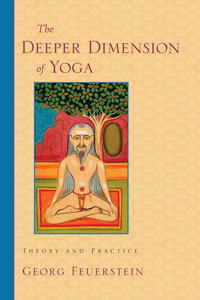
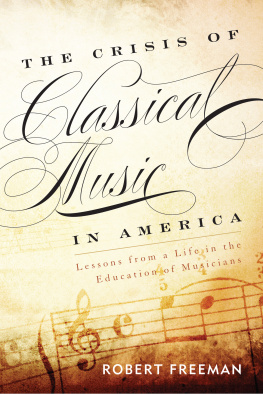

![Freeman - Pro design patterns in Swift: [learn how to apply classic design patterns to iOS app development using Swift]](/uploads/posts/book/201359/thumbs/freeman-pro-design-patterns-in-swift-learn-how.jpg)
